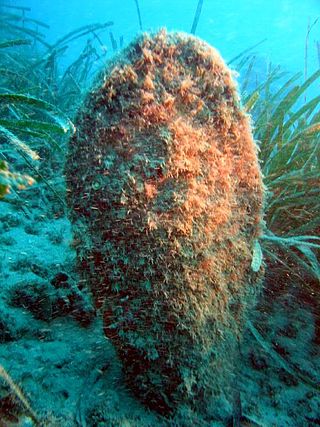
Pinnation is the arrangement of feather-like or multi-divided features arising from both sides of a common axis. Pinnation occurs in biological morphology, in crystals, such as some forms of ice or metal crystals, and in patterns of erosion or stream beds.

The pygmy killer whale is a poorly known and rarely seen oceanic dolphin. It is the only species in the genus Feresa. It derives its common name from sharing some physical characteristics with the orca also known as the killer whale. It is the smallest cetacean species that has the word "whale" in its common name. Although the species has been known to be extremely aggressive in captivity, this aggressive behavior has not been observed in the wild.

The pantropical spotted dolphin is a species of dolphin found in all the world's temperate and tropical oceans. The species was beginning to come under threat due to the killing of millions of individuals in tuna purse seines. In the 1980s, the rise of "dolphin-friendly" tuna capture methods saved millions of the species in the eastern Pacific Ocean and it is now one of the most abundant dolphin species in the world.

The knobcone pine, Pinus attenuata, is a tree that grows in mild climates on poor soils. It ranges from the mountains of southern Oregon to Baja California with the greatest concentration in northern California and the Oregon-California border.

The auricle or auricula is the visible part of the ear that is outside the head. It is also called the pinna, a term that is used more in zoology.

Agave attenuata is a species of flowering plant in the family Asparagaceae, commonly known as the foxtail or lion's tail. The name swan's neck agave refers to its development of a curved inflorescence, unusual among agaves. Native to the plateaux of central west Mexico, as one of the unarmed agaves, it is popular as an ornamental plant in gardens in many other places with subtropical and warm climates.

Trichomycteridae is a family of catfishes commonly known as pencil catfishes or parasitic catfishes. This family includes the candiru fish, feared by some people for its alleged habit of entering into the urethra of humans. They are one of the few parasitic chordates. Another species is the life monsefuano which was important to the Moche culture and still an important part of Peruvian cuisine.

Banksia attenuata, commonly known as the candlestick banksia, slender banksia, or biara to the Noongar people, is a species of plant in the family Proteaceae. Commonly a tree, it reaches 10 m (33 ft) high, but it is often a shrub in drier areas 0.4 to 2 m high. It has long, narrow, serrated leaves and bright yellow inflorescences, or flower spikes, held above the foliage, which appear in spring and summer. The flower spikes age to grey and swell with the development of the woody follicles. The candlestick banksia is found across much of the southwest of Western Australia, from north of Kalbarri National Park down to Cape Leeuwin and across to Fitzgerald River National Park.

The Asian gray shrew is a species of mammal in the family Soricidae. It is found in Bhutan, Cambodia, China, India, Laos, Malaysia, Myanmar, Nepal, Pakistan, the Philippines, Thailand, and Vietnam. It is one of the commonest species within its range and the International Union for Conservation of Nature has assessed its conservation status as being of "least concern".

Cetopsis is a genus of catfishes of the family Cetopsidae.

Samoana attenuata is a species of air-breathing tropical land snail, a terrestrial pulmonate gastropod mollusk in the family Partulidae. This species is endemic to French Polynesia.

Pinna is a genus of bivalve molluscs belonging to the family Pinnidae.

Haworthiopsis fasciata, formerly Haworthia fasciata, is a species of succulent plant from the Eastern Cape Province, South Africa. The species is rare in cultivation; most plants that are labelled as H. fasciata are actually Haworthiopsis attenuata.

Pinna nobilis, whose common name is the noble pen shell or fan mussel, is a large species of Mediterranean clam, a marine bivalve mollusc in the family Pinnidae, the pen shells.

Castilleja attenuata is a species of Indian paintbrush, known by the common names valley tassels, attenuate Indian paintbrush, and narrowleaf Owl's-clover. It is native to western North America from British Columbia, through California, to Baja California, where it grows in grasslands and open woodland habitats.

Nicotiana attenuata is a species of wild tobacco known by the common name coyote tobacco. It is native to western North America from British Columbia to Texas and northern Mexico, where it grows in many types of habitat. It is a glandular and sparsely hairy annual herb exceeding a meter in maximum height. The leaf blades may be 10 centimetres (4 in) long, the lower ones oval and the upper narrower in shape, and are borne on petioles. The inflorescence bears several flowers with pinkish or greenish white tubular throats 2 to 3 centimetres long, their bases enclosed in pointed sepals. The flower face has five mostly white lobes. The fruit is a capsule about 1 centimetre long.

Attenuata is a genus of minute sea snails, marine gastropod mollusks or micromollusks in the family Lironobidae.
The Chinese white-toothed shrew is a species of mammal in the family Soricidae.

Haworthiopsis attenuata, formerly Haworthia attenuata, commonly known as zebra haworthia, is a small species of succulent plant from the Eastern Cape Province, South Africa. As an ornamental, it is one of the most commonly cultivated of the Haworthiopsis species.


















